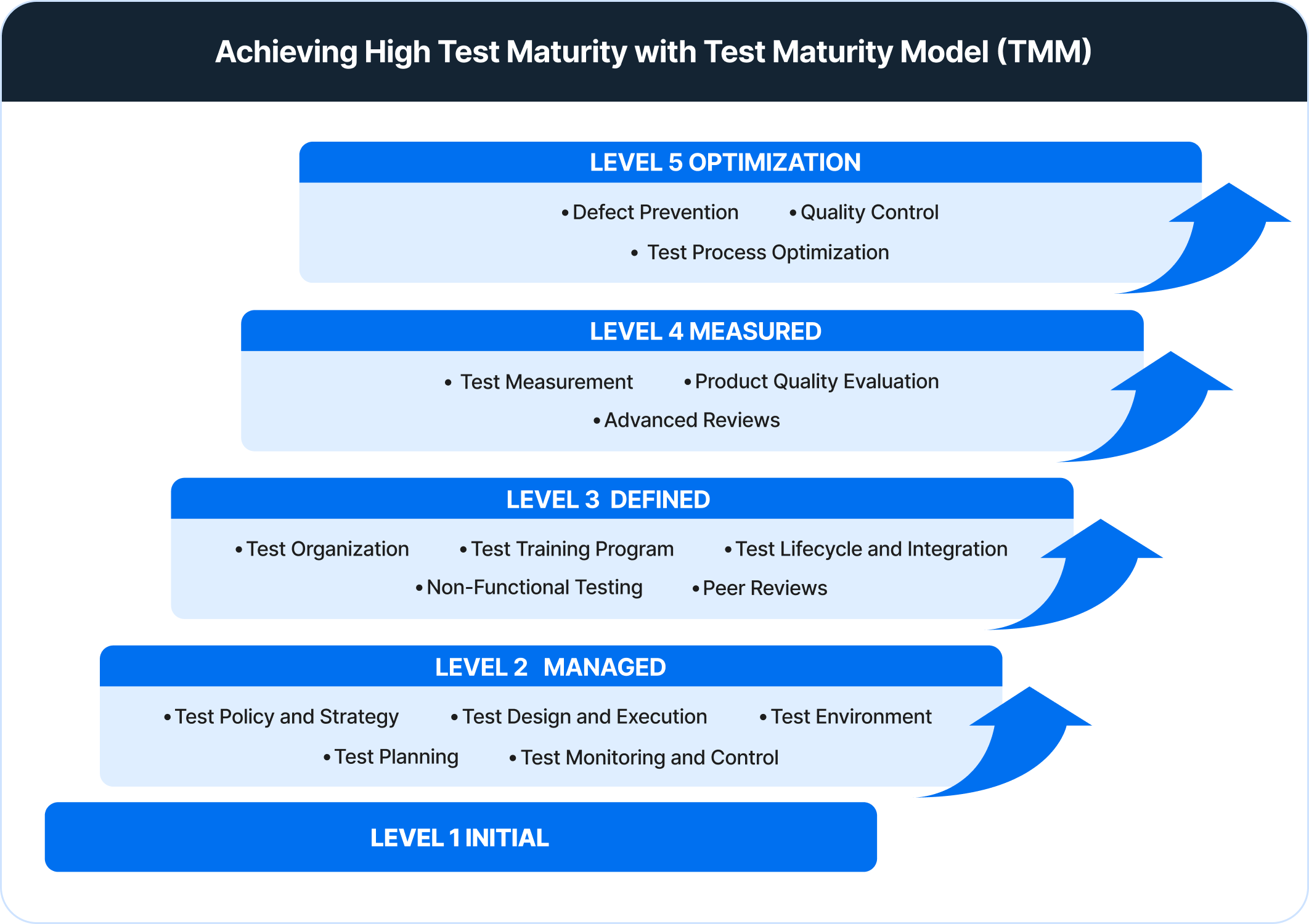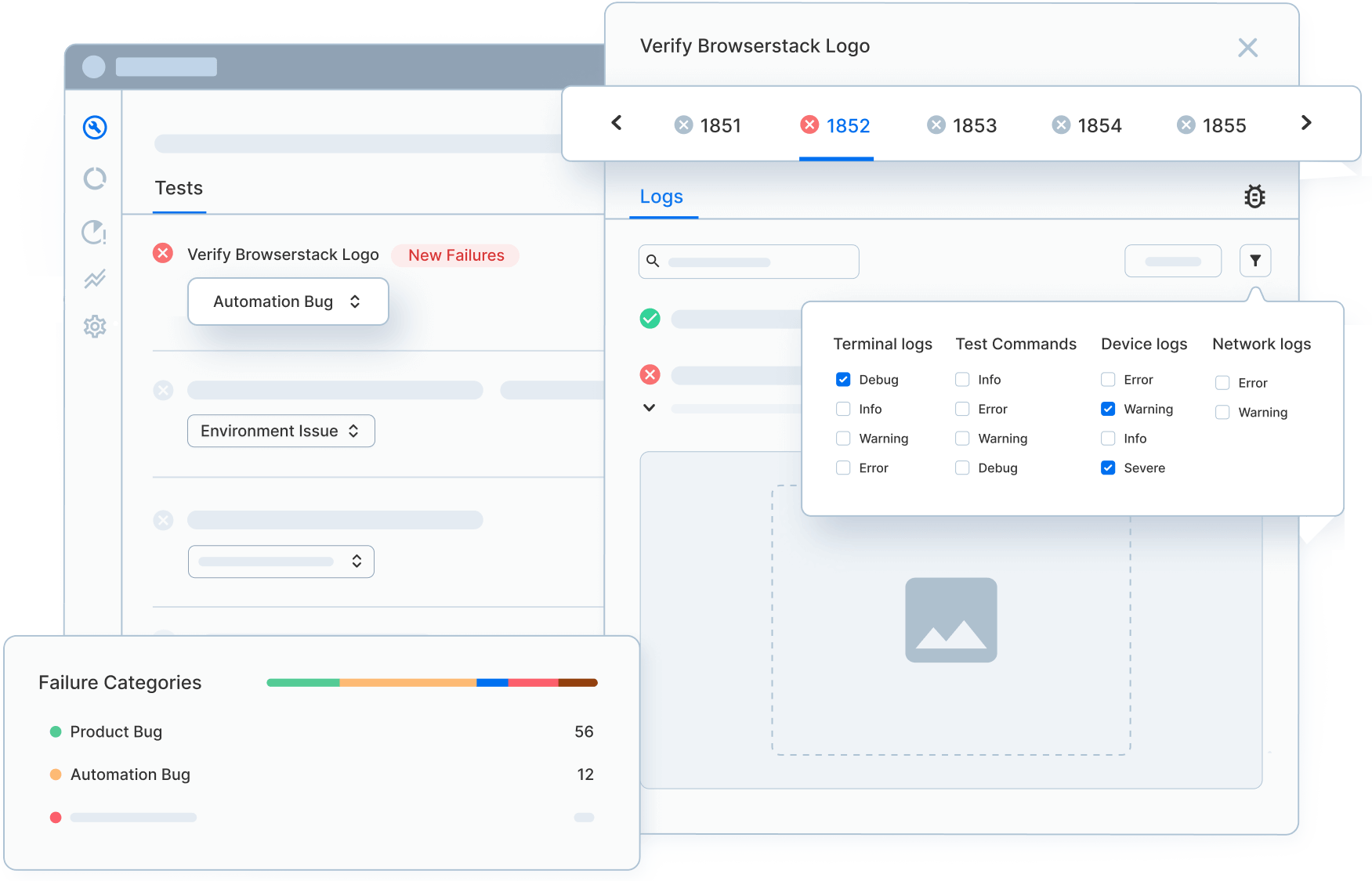Testing often feels like it should be working. Automation is in place. Test suites keep expanding. Release cycles move faster than before.
But why do the same defects keep escaping?
In practice, effort keeps increasing while outcomes stay unpredictable. Something is missing, and it isn’t due to another tool or framework.
The missing piece is visibility into how mature testing actually is.
The Test Maturity Model (TMM) answers that gap. It exposes where testing truly stands today and what must improve next—across planning, execution, ownership, and continuous improvement—so progress follows a clear path instead of guesswork.
Overview
What is Test Maturity Model?
The Testing Maturity Model (TMM) is a framework developed in 1996 to assess and improve the maturity of software testing processes within an organization, helping teams evaluate current practices and set goals for higher efficiency and quality.
Benefits of Test Maturity Model
- Ensures consistent testing practices across teams.
- Evaluates testing adequacy to prevent quality gaps.
- Identifies weaknesses and suggests actionable improvements.
- Encourages ongoing refinement of testing methods.
- Designed explicitly for software testing needs.
- Adopts smoothly without disrupting existing workflows.
Levels of Test Maturity Model
- Level 1 Initial: Testing is informal and unstructured, with minimal processes in place.
- Level 2 Managed: Basic testing processes are established, focusing on planning and tracking.
- Level 3 Defined: Testing activities are standardized and integrated into the software development lifecycle.
- Level 4 Management & Measurement: Testing is measured, evaluated, and managed for efficiency and effectiveness.
- Level 5 Optimized: Testing processes are continually improved and optimized using advanced tools and techniques.
In this article, I’ll share how I used TMM to improve our testing practices and why it could be the missing piece to your testing strategy in 2026.
What is Testing Maturity?
Software test maturity refers to how well an organization plans, executes, measures, and improves its testing practices over time.
It reflects the extent to which testing is consistent, structured, automated, and aligned with business risk rather than being ad hoc or reactive.
A mature test process generally tends to comprise:
- Established policies: Well-defined and documented testing policies adhered to across an organization.
- Test Planning: A documented test plan and process which specifies objectives, resource allocation, schedules, and a breakdown of tasks.
All you need to know about Test Planning right here.
- Test lifecycle: The step-by-step process consisting of phases and activities. Involves planning, review, design, execution, maintenance, and result analysis.
- Team: The testing team that crafts test cases, runs them, and examines the results.
- Relevant metrics: Test-related metrics required to ascertain test performance and product quality.
Good to know: Essential Metrics for the QA Process
- Testing Tools: The right tools to enable test execution, result reporting, debugging, and documentation. Tools must also allow tracking of results, error recording, and performance evaluation.
Try Testing Your Website for Free
A mature testing process requires support from management and has to be built into the organizational culture. It is capable of continuous growth, improvement, and expansion.
What is Test Maturity Model (TMM)?
The Test Maturity Model (TMM) is a structured framework used to evaluate and improve an organization’s software quality management processes. It defines progressive levels of testing maturity, helping teams assess how effectively testing is planned, managed, automated, and integrated into the software development lifecycle, and provides guidance on moving from reactive testing to optimized, risk-driven quality practices.
The Testing Maturity Model (TMM) in Software Testing was developed in 1996 at the Illinois Institute of Technology. It lays out a set of levels through which a team or organization can move towards higher test maturity.
TMM in software testing can also be used to evaluate how mature the current test pipelines are. Once the current maturity has been measured, the TMM can also help decide targets to achieve when moving to higher maturity levels.
The Testing Maturity Model is based on the Capability Maturity Model (CMM), created earlier by the same Institute.
This video discusses the challenges of building a strong QA organization. Industry experts Anand Subbaraman (QA and engineering leader), Maaret Pyhäjärvi (software testing consultant and author), Jan Acosta (quality engineering leader), and Sowmya Sridharamurthy (QA and delivery transformation expert) share practical insights on overcoming QA growing pains and building sustainable testing practices.
Importance of Test Maturity Models (TMM)
TMM provides a structured framework to enhance software testing quality. Key reasons for its importance include:
- Standardized Processes: Ensures consistent and streamlined testing practices across projects and teams.
- Quality Assessment: Measures testing adequacy to avoid gaps impacting application quality.
- Improvement Identification: Pinpoints weaknesses and offers actionable insights for improvement.
- Continuous Enhancement: Drives ongoing refinement of testing methods for better outcomes.
- Testing-Focused: Explicitly tailored for testing needs, unlike generic maturity models.
- Seamless Integration: This can be adopted at any stage without disrupting current testing efforts.
In the video in the previous section, Jan Acosta (QA leader) emphasizes that test maturity stalls when automation is treated as optional work instead of a core delivery requirement.
Levels of Test Maturity Model in Software Testing
Every TMM level is a stage of test maturity. It defines testing capability and goals. Each TMM level contains:
- Goals to be met to achieve that particular benchmark of maturity.
- Scope, limitations, and boundaries of the level.
- Tasks and responsibilities required to achieve said goals.
TMM Level 1 – Initial
At this level, testing is inconsistent, disordered, chaotic, and undefined. There is no documentation in place, which makes reusing test cases close to impossible. There are also no standards or templates for QA deliverables. Testing is mostly confined to debugging, without too much focus on overall product quality. The intention at this stage is to run tests without encountering any significant failures.
This stage verifies that the software fulfills the users’ basic requirements. It cannot do more since the testing process at Level 1 lacks more than minimal resources, tools, and skilled personnel. The success of testing depends on individual skills without much team or organizational support.
TMM Level 2 – Managed
At this level, the test process is defined, structured, and established into a cohesive, executable strategy. Test plans, cases, and procedures are put in place with a focus on requirements and specifications. Formal test design methods are used, and process areas are set up:
- Test Policy and Goals
- Test Planning
- Test Techniques and Methods
- Test Environment
The primary intent, at this stage, is to monitor and verify that software doesn’t just function but meets particular requirements. This moves beyond debugging, and actively explores techniques that evaluate software quality.
TMM Level 3 – Defined
At this level, the testing pipeline is integrated into the software development lifecycle. It becomes a legitimate and permanent part of the V-Model (Validation Model). Test phases are conducted in parallel with each developmental phase – as the V model requires.
In each sprint, the sprint development phase is followed by testing. An independent QA team examines the software with predetermined requirements in mind. However, at this stage, testing objectives also take risk management into account.
Start implementing risk-management with risk-based testing in Agile.
Test planning is done at the beginning of project ideation, right after requirements have been outlined. Test strategy is laid out with risk management in mind. Tests are run according to schedule, results are examined to verify that software satisfies requirements and is designed to mitigate risk as far as possible.
The process areas of relevance here are:
- Test Organization
- Test Life Cycle and Integration
- Control and Monitor
TMM Level 4 – Management & Measurement
At this stage, requirements and goals are measured for better management. Reviews and inspection activities are introduced into the lifecycle as a part of testing.
QA activities now include measuring quality markers such as usability, reliability, and maintainability. Bugs are recorded and ascribed levels of severity.
Read More: Bug Severity vs Bug Priority in Testing
Test cases are also documented and chronicled in a singular database to be reused and utilized in regression testing. The intent here is to provide greater visibility and data regarding test process and software quality.
Relevant process areas are:
- Peer Reviews
- Test Measurement & Quantification
- Software Quality Determination
TMM Level 5 – Optimized
At this level, after the steps undertaken in the previous levels, testing has become a comprehensively defined process – result-oriented and highly productive in terms of cost benefits and effectiveness. Techniques, methods, and metrics are validated and consistently applied while making space for continuous improvement in every iteration. Steps are also taken to prevent defects by eliminating obvious inadequacies in processes.
Tools are widely and extensively used to support tests, record, analyze and report results. The entire process operates at the highest possible strata of operation to achieve the following:
- Defect Prevention
- Quality Control
- Test Process Optimization
What is Test Maturity Model Integration (TMMi)?
The Test Maturity Model Integration (TMMi) is a structured framework used to assess and improve the maturity of software testing processes within an organization. It offers a systematic approach to evaluate current testing practices and guide improvements that align with business goals and quality standards.
Read More: 21 Techniques to Improve Software Quality
Purpose of TMMi
TMMi is designed to help organizations:
- Identify gaps and inefficiencies in their test processes
- Benchmark their maturity level against industry standards
- Implement consistent, measurable improvements
- Reduce defects and improve overall product quality
- Align testing efforts with organizational objectives
Read More: What are Software Testing Standards
TMM vs TMMi
TMMi (Test Maturity Model Integration) is the modern successor to the original TMM (Test Maturity Model). While both aim to improve software testing processes, TMMi offers a more structured, updated, and globally accepted framework aligned with current industry practices.
| Feature | TMM (Test Maturity Model) | TMMi (Test Maturity Model Integration) |
|---|---|---|
| Developed By | Illinois Institute of Technology | TMMi Foundation |
| Introduction Year | Late 1990s | 2005 |
| Status | Outdated | Actively maintained and widely adopted |
| Structure | 5 maturity levels | 5 maturity levels with defined process areas and goals |
| Alignment with CMMI | Limited | Designed to integrate with CMMI |
| Focus | Core testing practices | Holistic test process improvement including metrics, reviews, and defect prevention |
| Applicability | Best for academic understanding | Suitable for real-world adoption across Agile and traditional teams |
| Industry Recognition | Limited | Industry standard for test maturity assessment |
Read More: Front-End Testing Strategy: A Detailed Guide
Capability Maturity Model (CMM) vs Test Maturity Model (TMM)
Below are some key differences between Capability Maturity Model (CMM) and Test Maturity Model (TMM).
| Aspect | CMM (Capability Maturity Model) | TMM (Test Maturity Model) |
|---|---|---|
| Focus | Overall software development and project management processes. | Specifically targets software testing processes. |
| Purpose | Improves and refines overall software development practices. | Assesses and enhances the maturity of testing practices. |
| Maturity Levels | Five levels: Initial, Repeatable, Defined, Managed, Optimizing. | Five levels: Initial, Definition, Integration, Management and Measurement, Optimization. |
Read More: Set Up a Strong QA Process
How to achieve high test maturity using TMM in 2026?
Studying the Test Maturity Model (TMM) helps QAs, QA managers, and stakeholders identify areas where their test cycles can improve to progress to the next stage. The first step is to assess the current QA processes and match them with the corresponding TMM level. Once this is done, the necessary steps can be taken to advance test maturity to the next level.
Evolution Through TMM Levels
From Level 1 to Level 2
At Level 1, testing is unsystematic, inconsistent, and reactive, lacking control. Transitioning to Level 2 involves implementing basic project management practices, such as defining and documenting rudimentary processes, standards, and methods. These processes must be made reusable. The goal is establishing a Defined stage where processes are structured and predictable.
In the video embedded earlier in this article, Anand Subbaraman (QA and engineering leader) frames the maturity journey as progress made in small steps, not a one-time transformation, with compounding benefits over time.
From Level 2 to Level 3
Once basic processes are in place, they must be communicated to relevant personnel. This may require training to ensure everyone applies the standards effectively. Motivating the team and providing the necessary resources is crucial. Level 3 focuses on documentation, process standardization, and better integration of people and pipelines to make processes more cohesive and aligned across the team.
Also Read: What is Quality Assurance Testing?
From Level 3 to Level 4
At Level 4, processes defined in Level 3 must be measured using quantifiable metrics to gain better control. The goal is to break down larger methods into smaller segments and evaluate each component to understand the overall performance. Regular audits will help ensure teams follow defined procedures. By quantifying the processes, managers can predict resource needs and process requirements, making testing predictable and manageable.
Getting the basics right: How to set up QA processes from scratch
From Level 4 to Level 5
Level 5 marks the pinnacle of test maturity, where innovation becomes key. The focus shifts to re-engineering existing methods using insights gained from Level 4 and applying new tools, frameworks, and technologies. Benchmarking against industry standards and competitors will provide new ways to improve. Continuous improvement is emphasized, and the goal is to cultivate an Agile mindset to optimize testing practices.
Refer to this case study to see how Optimizely, a digital experience and experimentation platform, achieved higher levels of test maturity by moving testing to the cloud with BrowserStack. Optimizely improved coverage, reliability, and release speed while reducing infrastructure overhead.
Advantages of Test Maturity Model
Below are some key advantages of a TMM:
- Helps Analyze the Current Situation: TMM provides an overview of the current testing process, helping identify issues that could be overlooked without a structured approach.
- Explores Areas of Improvement: TMM highlights areas for improvement in the testing process, enabling teams to address weaknesses before they cause bugs.
- Complete Focus on Testing: TMM is focused solely on testing, ensuring that the testing processes are refined and optimized for success.
- Saves Organization Costs: By addressing defects early, TMM reduces the need for expensive fixes later, lowering overall project costs.
- Lower Risks: TMM helps identify and close gaps in testing, reducing risks and ensuring a smoother software release process.
- Ensures Synchronization with Requirements: Regular reviews from Level 3 onward ensure that the work aligns with software requirements, improving testing coverage and product quality.
Disadvantages of Test Maturity Model
Below are some key limitations of a TMM:
- Time Consumption: TMM requires continuous investment of time and resources, which might seem inefficient in time-sensitive projects.
- Hard to Maintain: Maintaining high maturity levels requires ongoing effort and resources, which can be challenging for smaller organizations.
- No Scope for Customization: TMM follows a fixed process with little room for customization based on an organization’s specific needs, limiting its flexibility.
Conclusion
TMM in software testing is a handy framework for judging QA processes and developing better ones. However, no matter the level of test maturity, something that is non-negotiable for consistently accurate results is real device testing.
It must be run on a real device cloud. This applies to manual testing and automation testing. Without real devices, there is no way to be sure that software is performing as it would in real user conditions, such as a low battery, incoming calls, weak network strength, etc.
BrowserStack’s device cloud provides 3500+ real browsers and devices for on-demand testing anytime, anywhere. Its cloud Selenium grid offers the same number of real devices and browsers for automated Selenium testing. Users can also opt for Cypress testing on 30+ versions of the latest browsers across Windows and macO. Use instant, hassle-free parallelization to get faster results without compromising on accuracy.







